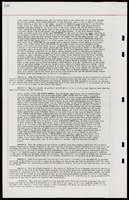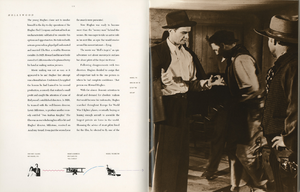Search the Special Collections and Archives Portal
Search Results
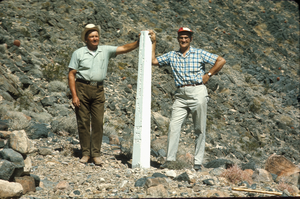
Slide of John Lytle at Emigrant (Fremont) Gap on the Old Spanish Trail, California, circa 1960s
Date
Archival Collection
Description
Image
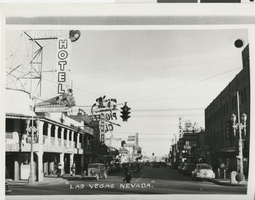
Photograph of Overland Hotel on Fremont Street, Las Vegas, Nevada, 1940s
Date
Archival Collection
Description
Image

Photograph of an unidentified man and his dog, circa 1920s-1930s
Date
Archival Collection
Description
Image
White Cross Drug Store Scrapbook
Identifier
Abstract
The White Cross Drug Store Scrapbook (1950-1964) contains photographs, employee training materials, newspaper clippings, advertisements, displays, and some historical narrative and press release material on the history and mission of the White Cross Drug Store. It also includes advertising ephemera and brochures on cosmetic products and perfumes of the early 1950s.
Archival Collection

Transcript of interview with Mike and Sallie Gordon by Adriane Massa, March 2, 1977
Date
Archival Collection
Description
Mike Gordon speaks about their liquor stores and lists his occupation as a bartender. Among the civic organizations that he participated in were: Young Democrats, Eagles Lodge, Lions Club, past president of Temple Beth Sholom and B'nai B'rith Lodge. Together Mike and Sallie recall the growth and changes of the valley they have witnessed between the early 1930s and mid-1970s. Among his anecdotes is one about the carrying of payroll checks to Boulder Dam to avoid "interference" (robberies).
Mike and Sallie were among the very first people of Jewish ancestry to make their way to Las Vegas. They arrived January 26, 1932 to join relatives of Sallie?s who had moved to Las Vegas when the Boulder Dam construction began. They had married in 1930 in Pittsburgh, Pennsylvania. Soon they were involved members of a small but growing group of Jewish pioneers and helped found Temple Beth Sholom, the community?s first synagogue. Mike speaks about their liquor stores and lists his occupation as a bartender. Among the civic organizations that he participated in were: Young Democrats, Eagles Lodge, Lions Club, past president of Temple Beth Sholom and B?nai B?rith Lodge. Together Mike and Sallie recall the growth and changes of the valley they have witnessed between the early 1930s and mid-1970s. Among his anecdotes is one about the carrying of payroll checks to Boulder Dam to avoid ?interference? (robberies).
Text

Photographs of El Cortez Hotel and Casino at dusk, Las Vegas (Nev.), April 10, 2016
Date
Archival Collection
Description
Site name: El Cortez Hotel & Casino (Las Vegas, Nev.)
Site address: 600 Fremont St
Sign owner: IKE Gaming Inc
Sign details: 2,77 acre lot, with an original construction year of 1941.
Sign condition: 5 - fully functional, looks well taken care of, no damage to the sign, even looks original.
Sign form: Back to back Architectural sign
Sign-specific description: Double sided architectural sign perched on top of the building of the El Cortez reads El Cortez HOTEL COFFEE SHOP & BAR FREE PARKING with a metal frame work to hold it high for tourists to see down Fremont Street on either side of the road or sidewalk. in the Day it looks white and baby blue with the frame work painted white. At night El Cortez glows red whit what looks like white skeleton neon outlining the wording, HOTEL is outlined with pink skeleton neon, and COFFEE SHOP & BAR FREE PARKING is made of the same pink neon as the HOTEL portion.
Sign - type of display: Neon
Sign - media: Steel
Sign environment: The property is surrounded by other casinos, restaurants, and bars.
Sign - date of installation: circa 1941
Sign - date of redesign/move: Possible change in signage around 1946
Sign - thematic influences: Spanish revival (mission) style, the facade was faced with bricks with weeping mortar and the roof was red tile while a large metal sign announced the casino clubs name.
Sign - artistic significance: Spanish Revival / Western cowboy themes were popular in Vegas especially in the 30s and 40s due to the image pushed to look like the wild west or as a pioneer town.
Survey - research locations: Las Vegas Then and Now, Spectacular, assessor's website
Surveyor: Danny Jacobs
Survey - date completed: 2017-09-04
Sign keywords: Neon; Steel; Architectural; Back to back; Incandescent; Reader board; Marquee; Roof Sign
Mixed Content
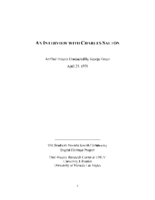
Transcript of interview with Charles Salton by George Green, April 23, 1976
Date
Archival Collection
Description
Interview with Charles Salton by George Green on April 23, 1976. Salton discusses arriving in Las Vegas in 1929, after his family had moved from New Jersey to Huntington Beach, California. His father sold real estate, and expected a boom after the authorization for the construction of Hoover Dam. His father was involved in bootlegging and then owned Al's Bar, a drinking and gambling establishment, on the alley at South First Street. Salton describes the area around Fremont Street and Las Vegas Boulevard with businesses and grocery stores, the grammar school and high school, and the hospital. Salton talks about his social activities, including involvement in the Jewish Community Center (Temple Beth Sholom), and several of the bars, clubs and casinos in the area. He briefly discusses the mob influence in the casinos versus corporate ownership and then speaks about the education system in Clark County.
Text

